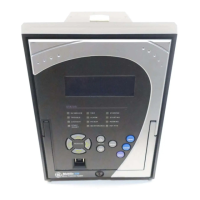
Do you have a question about the GE 339 and is the answer not in the manual?
| Brand | GE |
|---|---|
| Model | 339 |
| Category | Protection Device |
| Language | English |
Summary of the 339 Motor Protection System's features and benefits.
Technical details and operating parameters of the relay.
Compliance standards and test levels applied to the device.
Operating and storage environmental conditions.
Procedures for physical mounting and installation of the relay.
Procedures for connecting the relay electrically.
Visual representations of common wiring configurations.
Requirements and safety precautions for control power supply.
Connecting and configuring digital inputs.
Functionality and operation of trip and close output relays.
Overview of user interaction via the relay's front panel.
Navigation and operation using the front panel keypad.
Diagnosis and handling of relay self-test failures.
Procedures for installing and using the EnerVista setup software.
Establishing communication between software and relay.
Applying saved configuration settings to the relay.
Procedure for updating the relay's firmware.
Real-time status of the motor and its operation.
Display of measured electrical quantities like current, voltage, and power.
Accessing historical data logs, including events and faults.
Real-time operational status messages displayed on the relay.
Simplified initial configuration using the front panel interface.
Parameters adjustable via the quick setup menu for initial configuration.
Overview of the relay's configuration parameter structure.
Core relay configuration settings including clock and communications.
Implementing access control for relay settings and functions.
Configuration of network and serial communication interfaces.
Configuration of system and hardware parameters like CT, VT, and motor settings.
Settings for current transformer inputs.
Settings for voltage transformer inputs.
Parameters specific to motor characteristics.
Configuration of all motor protection functions.
Settings for motor thermal protection and overheating detection.
Settings for phase short circuit protection.
Settings for ground fault and sensitive ground fault protection.
Settings for phase overcurrent protection with time delays.
Configuration of control functions like logic elements and breaker control.
Creating custom logic functions using inputs and outputs.
Settings for detecting breaker failure or a welded contactor.
Settings for detecting issues with current transformer wiring.
Settings to prevent motor starts under specific conditions.
Configuration of physical inputs and output relays.
Configuration of output relays for Option E.
Monitoring system parameters like demand and power.
Monitoring of electrical demand parameters.
Monitoring motor operational hours and generating alarms.
Monitoring breaker operational status and components.
Assessing the operational condition and history of the breaker.
Procedures for performing functional tests on the relay.
Testing the functionality of output relays by forcing their state.
Information regarding product warranty terms and conditions.
Procedures for returning the device for repair and required documentation.
History of manual revisions and major updates to the product.